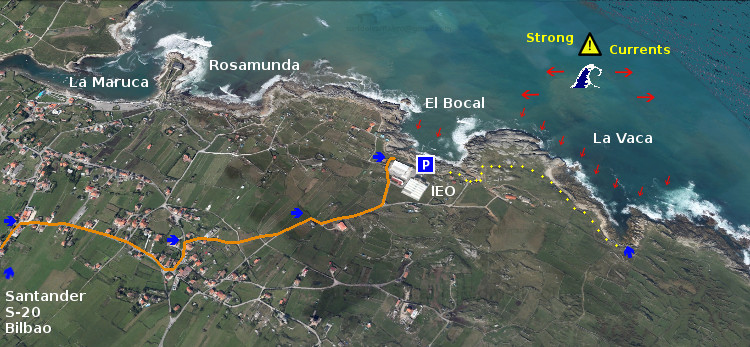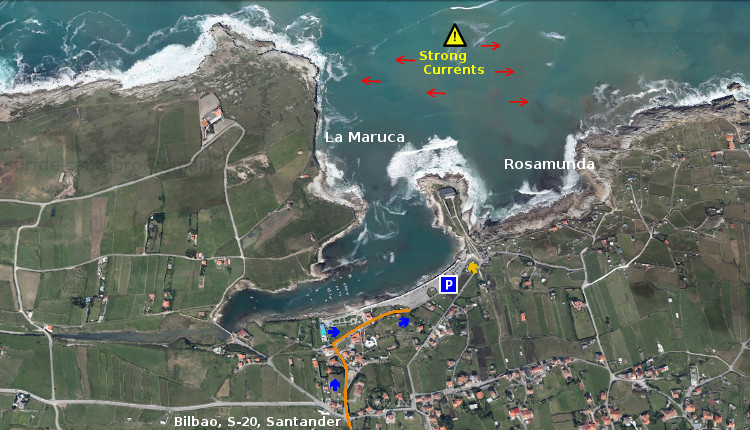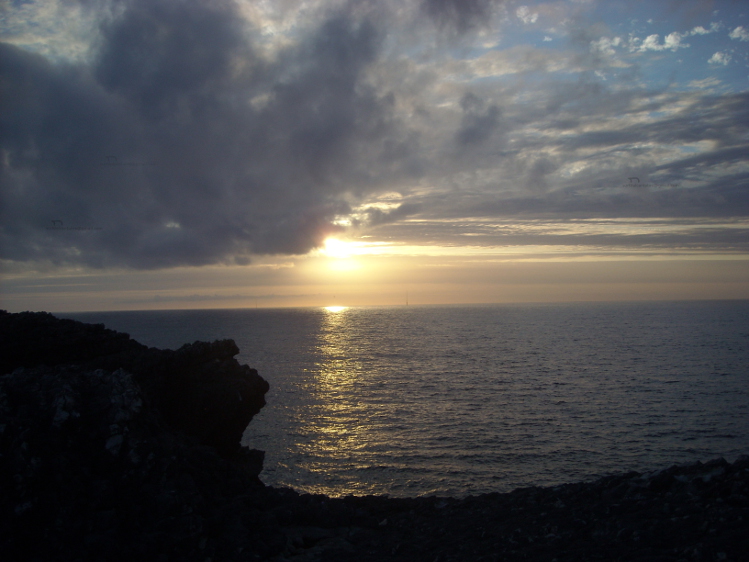Tag Archives: Santander
La Vaca, Acceso
![]() La Vaca es accesible desde el Barrio Monte-Corbanera de la ciudad de Santander. Una vez en esta zona y siguiendo los carteles indicativos, nos dirigimos hacia el Instituto Español de Oceanografía. En la parte trasera del IEO existe un área a modo de parking. Desde el aparcamiento vemos la playa de El Bocal. A la derecha, siguiendo un pequeño sendero externo a las fincas privadas de la zona, se encuentra la última cala. Allí es donde se forma la ola gigante de La Vaca.
La Vaca es accesible desde el Barrio Monte-Corbanera de la ciudad de Santander. Una vez en esta zona y siguiendo los carteles indicativos, nos dirigimos hacia el Instituto Español de Oceanografía. En la parte trasera del IEO existe un área a modo de parking. Desde el aparcamiento vemos la playa de El Bocal. A la derecha, siguiendo un pequeño sendero externo a las fincas privadas de la zona, se encuentra la última cala. Allí es donde se forma la ola gigante de La Vaca.
La Vaca, access
![]() La Vaca is accessible from the Neighborhood Monte-Corbanera of the city of Santander. Once in this area and following the signs, we headed toward the Spanish Institute of Oceanography (IEO). At the rear of the IEO there is an area for parking. From the parking area we see the beach of El Bocal. To the right, through a small trail that is out of the private farms in the area, is the last cove. This is where grows the big wave called La Vaca.
La Vaca is accessible from the Neighborhood Monte-Corbanera of the city of Santander. Once in this area and following the signs, we headed toward the Spanish Institute of Oceanography (IEO). At the rear of the IEO there is an area for parking. From the parking area we see the beach of El Bocal. To the right, through a small trail that is out of the private farms in the area, is the last cove. This is where grows the big wave called La Vaca.
 Acceso/Access
Acceso/Access

![]()
La Vaca, Localización
![]() La Vaca está localizada en el barrio de Monte-Corbanera, situado en la costa norte de la ciudad de Santander. Su localización es complicada, ya que este spot no se encuentra registrado en las guías de viajes y mapas. Los enlaces que se muestran más abajo finalizan su trayecto en el Barrio Monte-Corbanera. De allí cogemos el desvío hacia el Instituto Español de Oceanografía (derecha), que cuenta en su parte trasera, con una pequeña zona a modo de parking. En la zona hay varios carteles que indican la dirección hacia el IEO. Una vez en el aparcamiento, vemos la entrada a la Playa del Bocal. La siguiente cala, situada a la derecha, es: La Vaca. Se muestran como puntos de partida Oviedo, Palencia, Santander y Bilbao, el resto de orígenes comparte el final del trayecto con esas localizaciones.
La Vaca está localizada en el barrio de Monte-Corbanera, situado en la costa norte de la ciudad de Santander. Su localización es complicada, ya que este spot no se encuentra registrado en las guías de viajes y mapas. Los enlaces que se muestran más abajo finalizan su trayecto en el Barrio Monte-Corbanera. De allí cogemos el desvío hacia el Instituto Español de Oceanografía (derecha), que cuenta en su parte trasera, con una pequeña zona a modo de parking. En la zona hay varios carteles que indican la dirección hacia el IEO. Una vez en el aparcamiento, vemos la entrada a la Playa del Bocal. La siguiente cala, situada a la derecha, es: La Vaca. Se muestran como puntos de partida Oviedo, Palencia, Santander y Bilbao, el resto de orígenes comparte el final del trayecto con esas localizaciones.
La Vaca, Localization
![]() La Vaca is located in the neighborhood of Monte-Corbanera , placed on the north coast of the city of Santander. Its location is complicated, because this spot is not registered in the travel guides and maps. The links shown below end the journey at the neighborhood Monte-Corbanera . From there you have to take the detour to the Spanish Institute of Oceanography (IEO) (right), which has in his rear, a small area by way of parking. In the zone there are several signs indicating the direction toward the IEO. Once in the parking lot, we see the entrance to the Beach of EL Bocal. The next cove, situated to the right, is: La Vaca. Are shown as points of departure Oviedo, Palencia, Santander and Bilbao, the rest of origins shares the end of the journey with these localizations.
La Vaca is located in the neighborhood of Monte-Corbanera , placed on the north coast of the city of Santander. Its location is complicated, because this spot is not registered in the travel guides and maps. The links shown below end the journey at the neighborhood Monte-Corbanera . From there you have to take the detour to the Spanish Institute of Oceanography (IEO) (right), which has in his rear, a small area by way of parking. In the zone there are several signs indicating the direction toward the IEO. Once in the parking lot, we see the entrance to the Beach of EL Bocal. The next cove, situated to the right, is: La Vaca. Are shown as points of departure Oviedo, Palencia, Santander and Bilbao, the rest of origins shares the end of the journey with these localizations.
 Localización/Localization
Localización/Localization
![]()
De La Maruca a La Vaca. Ruta de Senderismo
![]() La Maruca está ubicada en la localidad de Monte, perteneciente al municipio de Santander. Es la Maruca un puerto natural emplazado en la costa norte de la ciudad y blasonada por la orografia del litoral que esculpe el Mar Cantábrico.
La Maruca está ubicada en la localidad de Monte, perteneciente al municipio de Santander. Es la Maruca un puerto natural emplazado en la costa norte de la ciudad y blasonada por la orografia del litoral que esculpe el Mar Cantábrico.
Su paseo marítimo cuenta con un amplío parking desde donde comenzar la ruta. Una vez situados en ese punto, podemos contemplar la belleza de este puerto. Pequeñas barcas de pescadores se agolpan hacia el interior y el lado izquierdo del mismo. Allí desemboca la Ría de San Pedro, contribuyendo a modelar la singular forma de La Maruca. Al alcance de nuestra vista se eleva una estatua gigante de un pescador, homenaje a la gente del mar. En el lado derecho del paseo marítimo se puede visitar el Centro de Interpretación del Litoral, pequeño museo dedicado al mar y la costa de Cantabria.
Continuando el camino, a la otra parte del CIL, aparece la Playa de Rosamunda. Es pequeña y sólo hábil en marea baja. Su principal uso esta destinado a la pesca recreativa desde sus rocas. Los días en los que la mar esta plana es posible realizar submarinismo. Doradas, perlas, salmonetes, y jargos son algunas de las espcecies de peces que podemos encontrar. Su fondo rocoso e irregular se entremezcla con la arena que el oleaje deposita en la base de esta zona. Un momento de pausa en este lugar hace que los límites de La Maruca varíen y difuminen sus fronteras entre el azul del cielo nuboso y el azul oscuro del mar.
Ahora el sendero transcurre paralelo al acantilado, marcado en el suelo por el uso. El oleaje al encuentro con las rocas dispara el agua, haciendo que la espuma se suspenda en el aire. Las pequeñas gotas de agua y el olor puro del mar acompañan la travesía. En el otro extremo, y después de atravesar este escenario, la arena abundante en una esquina nos hace intuir la entrada natural y más cómoda a la playa.
Llegamos a un pequeño cabo dentro de este entorno. Entre los muros de las fincas particulares y el mar, se encuentra la roca por la que caminamos. Va perdiendo gradualmente su altura hasta finalizar a nivel del mar. La última parte del tramo es un acantilado a cuyo resguardo llegan las olas que entran en la Playa del Bocal. Su irregular fondo de roca, afilada por las olas, aumenta el disfrute de esta imagen contemplada desde tierra firme. Nacen , en la distancia cercana, unas olas características. Su tamaño medio y su definido recorrido estimulan la imaginación. Cuando las olas crecen de tamaño, succionan con mayor fuerza el fondo, dejando entrever a poca distancia de la superficie del agua, el fondo rocoso. A nuestra espalda, una base el Instituto Español de Oceanografía.
Al final de este tramo asoma la entrada a la Playa del Bocal. Avanza el sendero irregularmente hasta llegar a campo abierto. Las vacas pastan libres en este lugar. Una valla electrificada las separa de los caminantes. Paso a paso subimos una pequeña y suave colina formada por vegetación y roca kárstica. Desde ella divisaremos la última cala del trayecto, aquella donde se origina y habita una de las olas más grandes de Cantabria: La Vaca Gigante.
La Maruca to La Vaca. Trekking route
![]() La Maruca is located in the town of Monte, belonging to the municipality of Santander. It is a natural harbor located on the north coast of the city and blazon by the orography of the coastline that sculpts the Cantabrian Sea.
La Maruca is located in the town of Monte, belonging to the municipality of Santander. It is a natural harbor located on the north coast of the city and blazon by the orography of the coastline that sculpts the Cantabrian Sea.
Its promenade has a large car park from where to begin the route. In that point, we can contemplate the beauty of the port. Small fishing boats are crowded toward the inside and the left-hand side of the same. That place is The Stuary of San Pedro, helping to shape the unique configuration of La Maruca. In the scope of the view is raised a giant statue of a fisherman, a tribute to the people of the sea. On the right side of the promenade you can visit the Interpretation Center of the Coastline, small museum dedicated to the sea and the coast of Cantabria.
Continuing along the path, to the other part of the CYL, appears the Beach of Rosamunda. It is small and only available at low tide. Its main use is intended for the recreational fishing from the rocks. The days on which the sea is flat it is possible to make scuba diving. Gold, pearls, red mullet, and jargos are some of the espcecies of fish that we can find. Its rocky bottom and irregular is intermingled with the sand that the waves deposited in the base of the zone. A moment of pause in this place makes the limits of La Maruca may vary, and blur their boundaries because of the blue of the sky , the clouds and the dark blue of the sea.
Now the path runs parallel to the cliff face, marked on the ground by use. The waves to the encounter with the rocks shoot the water, making that the foam is suspended in the air. The small drops of water and the fresh sea smell accompany the voyage. On the other end, and after crossing this scenario, the sand in a abundant corner makes us sense the natural and more convenient entrance to the beach.
We arrived in a small cape within this environment. Between the walls of the private farms and the sea, is the rock through which we walked. It gradually lose their height up to finish at sea level. The last part of the zone is a cliff which guards the arrival of the waves that fall on the Beach of El Bocal. Its irregular rocky sea bottom, sharpened by the waves, increases the enjoyment of this image when we see it from the mainland. Some particular waves appear in the close distance. Its medium size and its defined path stimulate the imagination. When the waves grow in size, the sea sucks with greater force the fund, showing the rocky bottom near the surface of the water. To our backs, a basis of the Spanish Institute of Oceanography.
At the end of this stretch is the entrance to the beach El Bocal. The trail moves irregularly until you get to open field. The cows graze free in this place. An electric fence separates the hikers from the animals. Step by step we climb a small and soft hill, formed by vegetation and karstic rock. There we will see the last cove of the journey, where borns and inhabits one of the biggest waves in Cantabria: «La Vaca Gigante».
![]()
La Maruca, acceso
![]() La Maruca puede ser accedida desde muchos puntos. La Albericia, Monte, Cueto, y Valdenoja son barrios de Santander desde los cuales se puede llegar directamente a La Maruca. Debido a que la costa norte de la ciudad esta compuesta principalmente por casas individuales y una red de carreteras dispuestas en el terreno a modo de laberinto, es aconsejable usar los puntos de entrada que están señalizados en la vía de salida de la autovía S-20.
La Maruca puede ser accedida desde muchos puntos. La Albericia, Monte, Cueto, y Valdenoja son barrios de Santander desde los cuales se puede llegar directamente a La Maruca. Debido a que la costa norte de la ciudad esta compuesta principalmente por casas individuales y una red de carreteras dispuestas en el terreno a modo de laberinto, es aconsejable usar los puntos de entrada que están señalizados en la vía de salida de la autovía S-20.
La Maruca, access
![]() La Maruca can be accessed from many points. La Albericia, Monte, Cueto, and Valdenoja are neighborhoods of Santander from which you can reach directly to it. Due to the fact that the north coast of the city is mainly composed of individual houses and a network of small roads that seems a maze, it is advisable to use the entry points that are flagged in the exit path of highway S-20.
La Maruca can be accessed from many points. La Albericia, Monte, Cueto, and Valdenoja are neighborhoods of Santander from which you can reach directly to it. Due to the fact that the north coast of the city is mainly composed of individual houses and a network of small roads that seems a maze, it is advisable to use the entry points that are flagged in the exit path of highway S-20.
 Acceso/Beach Access
Acceso/Beach Access

![]()
La Maruca, Localización
![]() La Playa de La Maruca está situada en la ciudad de Santander. Es una playa semiurbana emplazada en la costa norte de la ciudad. Compuesta por rocas y arena, se situa entre acantilados que reducen su tamaño hasta desembocar en el paseo marítimo que da acceso a la playa. A la Maruca se puede llegar desde el centro de Santander o por autovía (S-20). Se muestra a continuación como puntos de partida Santander y Bilbao. El resto de orígenes finalizarán en la ruta que enlaza Santander con La Maruca o en la parte final del trayecto que se inicia en Bilbao.
La Playa de La Maruca está situada en la ciudad de Santander. Es una playa semiurbana emplazada en la costa norte de la ciudad. Compuesta por rocas y arena, se situa entre acantilados que reducen su tamaño hasta desembocar en el paseo marítimo que da acceso a la playa. A la Maruca se puede llegar desde el centro de Santander o por autovía (S-20). Se muestra a continuación como puntos de partida Santander y Bilbao. El resto de orígenes finalizarán en la ruta que enlaza Santander con La Maruca o en la parte final del trayecto que se inicia en Bilbao.
La Maruca, Localization
![]() The Beach of «La Maruca» is located in the city of Santander. It is a semi-urban beach located on the north coast of the city. It is Composed of rocks and sand, is located between cliffs that reduce its size up to lead to the promenade that gives access to the beach. «La Maruca» can be reached from the center of Santander or through the highway (S-20). Shown below as starting points Santander and Bilbao. The rest of origins will finish in the route that connects Santander with «La Maruca» or in the final part of the journey that starts in Bilbao.
The Beach of «La Maruca» is located in the city of Santander. It is a semi-urban beach located on the north coast of the city. It is Composed of rocks and sand, is located between cliffs that reduce its size up to lead to the promenade that gives access to the beach. «La Maruca» can be reached from the center of Santander or through the highway (S-20). Shown below as starting points Santander and Bilbao. The rest of origins will finish in the route that connects Santander with «La Maruca» or in the final part of the journey that starts in Bilbao.
 Localización/Localization
Localización/Localization
![]()
Playa de Valdearenas, Liencres; Localización
![]() La Playa de Valdearenas está situada en la localidad de Liencres, perteneciente al municipio de Piélagos. Esta playa también se conoce con el nombre de su localidad, Liencres. A la Playa de Valdearenas se puede llegar desde Oviedo, Palencia, Santander y Bilbao; como puntos de partida, todos los demás orígenes atraviesan por uno o varios de estos puntos. La llegada a las playas de Liencres no es está indicada en las guías oficiales, es por ello que la ruta finaliza en el Barrio Callejo de liencres. Llegando desde Oviedo encontramos la entrada a las playas antes de llegar al Barrio Callejo. Desde los demás puntos de partida debemos continuar la carratera hasta llegar al Parque natural de las Dunas de Liencres. La entrada esta bien señalizada.
La Playa de Valdearenas está situada en la localidad de Liencres, perteneciente al municipio de Piélagos. Esta playa también se conoce con el nombre de su localidad, Liencres. A la Playa de Valdearenas se puede llegar desde Oviedo, Palencia, Santander y Bilbao; como puntos de partida, todos los demás orígenes atraviesan por uno o varios de estos puntos. La llegada a las playas de Liencres no es está indicada en las guías oficiales, es por ello que la ruta finaliza en el Barrio Callejo de liencres. Llegando desde Oviedo encontramos la entrada a las playas antes de llegar al Barrio Callejo. Desde los demás puntos de partida debemos continuar la carratera hasta llegar al Parque natural de las Dunas de Liencres. La entrada esta bien señalizada.
Valdearenas Beach, Liencres; Localization
![]() Valdearenas Beach is located in the town of Liencres, belonging to the municipality of Piélagos. This beach is also known by the name of its locality, Liencres. To the beach of Valdearenas can be reached from Oviedo, Palencia, Santander and Bilbao; as points of departure, all other origins run through one or more of these points. The arrival to Liencres’s beaches is not is indicated in the official guides, is for it that the route finishes in the Neighborhood Callejo of liencres. Coming from Oviedo we find the entry to the beaches before arriving to the Neighborhood Callejo. From other points of item we must continue the road up to coming to the Nature Reserve of Liencres’s Dunes. The entry is well indicated.
Valdearenas Beach is located in the town of Liencres, belonging to the municipality of Piélagos. This beach is also known by the name of its locality, Liencres. To the beach of Valdearenas can be reached from Oviedo, Palencia, Santander and Bilbao; as points of departure, all other origins run through one or more of these points. The arrival to Liencres’s beaches is not is indicated in the official guides, is for it that the route finishes in the Neighborhood Callejo of liencres. Coming from Oviedo we find the entry to the beaches before arriving to the Neighborhood Callejo. From other points of item we must continue the road up to coming to the Nature Reserve of Liencres’s Dunes. The entry is well indicated.












